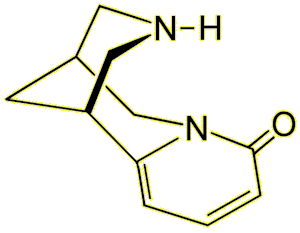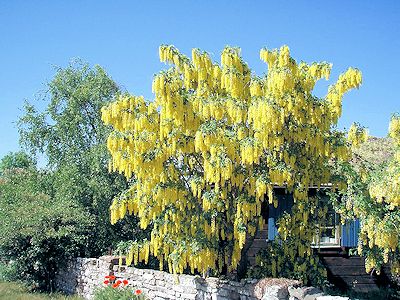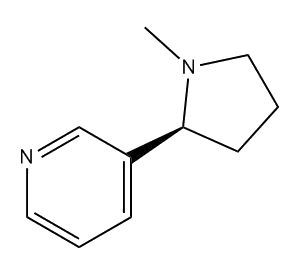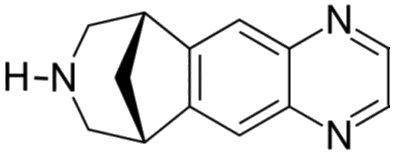
![]()
Cytisine
The poisonous plant that might
help people stop smoking
![]()
![]()
Molecule of the Month March 2019
Also available: JSMol version.
![]()

 |
CytisineThe poisonous plant that might
|
 |
As usual, it depends on the dosage. In large quantities cytisine is poisonous, but in smaller ones it may be beneficial.
 Common laburnum tree (Laburnum anagyroides) |
Where does it come from?Cytisine (not to be confused with cytosine) is an alkaloid that's found in almost all parts of the common laburnum tree (Laburnum anagyroides), leaves, bark, seeds, etc. These ornamental trees are quite hardy, and produce lots of pendulous yellow flowers. As such in the 1960's and 70's many laburnums were planted in parks or around schools to brighten them up. However, no-one had realised quite how poisonous they were, and this led to a 'laburnum hysteria' in the late 1970's following reports of children becoming sick after playing with and eating the seed pods, which look similar to regular peas. Indeed, at the time, 3000 hospital admissions a year were attributed to laburnum poisoning. This figure is probably exaggerated, as often the children’s stomachs were pumped as a precaution before they could be tested for poisoning or symptoms began to show. But as recently as 2007, children were taken to hospital after a primary school playground was extended into an area with overhanging laburnum branches. Fifteen children had to be admitted after they were caught playing with the seed pods. |
 Did no-one realise it was poisonous?
Did no-one realise it was poisonous?Apparently not, but that's not surprising as there are a great number of common household and garden plants that are poisonous, such as deadly nightshade (atropine amongst others), wolfsbane (source of aconitine), foxglove (digitalis), hemlock (coniine) and yew trees (taxanes). However, laburnum poisonings have been mentioned in literature for centuries, often in whodunnit mysteries as the murder 'weapon'.
Well, laburnum poisoning is mentioned in some of the Sherlock Holmes books, and in My Cousin Rachel by Daphne du Maurier, one of the main characters, Ambrose, dies slowly over a period of months from a sickness with symptoms remarkably like those of laburnum poisoning. When his heir, Philip, arrives to take control of the estate, he too fall sick with the same symptoms, nausea, vomiting, and weakness. Ambrose’s widow, Rachel, has a garden full of laburnum trees, and is known for her herbal remedies and teas, and Philip gradually begins to suspect her of being a poisoner. [Spoiler alert] But she dies in a fall before we find out if she really did it or not…
Apparently. Cytisine has been used as a substitute for nicotine for many decades in Eastern Europe, and was used as a cheap tobacco substitute by German and Russian soldiers during the Second World War (when real cigarettes were hard to obtain). It was marketed in 1964 as an anti-smoking aid under the brand name Tabex, now produced by the Bulgarian drug company Sopharma.
Studies on its effects have been published since the 1960s, however none of these early trials conformed to Western regulations and so the drug was not legalised in the West. Indeed, because many of the Eastern European countries have since joined the EU they have recently outlawed cytisine to be compliant with EU laws. The problem is that to achieve regulatory approval would require investment of more than $1 billion for research into the effectiveness and safety of cytisine in humans. The drug companies are unlikely to finance this because of the relatively small profit margins.
Not at all. There has been renewed interest in it following a burgeoning international online market for cytisine for smoking cessation, along with the success of a similar anti-smoking aid, varenicline, marketed by Pfizer and which currently has annual sales of $755M worldwide. As a result, British medical authorities offered to pay for and run the first modern clinical trial of cytisine. This was carried out in 2011 at University College London. The conclusion was that cytisine more than tripled a smoker's chances of quitting compared to a placebo. New Zealand researchers carried out a follow-up trial comparing cytisine with standard nicotine replacement therapy (NRT). The team studied 1,310 smokers who were trying to quit. For 2 months, half of them were given cytisine tablets, while the other half were given regular NRT. The researchers found that the smokers taking cytisine were far more successful in quitting smoking than those on NRT.
 |
 |
 |
| Cytisine | Nicotine | Varenicline |
Cytisine is a nicotinic acetylcholine receptor agonist, which means the molecule binds to the receptors which normally bind nicotine, satisfying the person's cravings for nicotine. But, unlike nicotine, cytisine is not addictive, so the doses of cytisine can be gradually reduced to zero, leaving the person free from their nicotine addition.
Yes, and also cytisine is far cheaper than other available anti-smoking aids, which makes it useful in poorer regions of the world where often people cannot afford NRT treatment.
Well, cytisine now has had two large-scale clinical trials showing its effectiveness, and in 2017 it was finally given FDA acceptance to proceed with clinical development of cytisine in the U.S. However it could still take several more years for full EU or FDA approval. Also, there may be a problem with supply. Currently, the world's cytisine supply comes from 100,000 laburnum trees planted in fields ringed by protective fences in Bulgaria. If the drug were to be legalised, we'd need to plant many more such plantantions. Until then, the best way to quit smoking, is of course, never to start in the first place!
![]()
![]()
![]() Back to Molecule of the Month page. [DOI:10.6084/m9.figshare.6139058]
Back to Molecule of the Month page. [DOI:10.6084/m9.figshare.6139058]